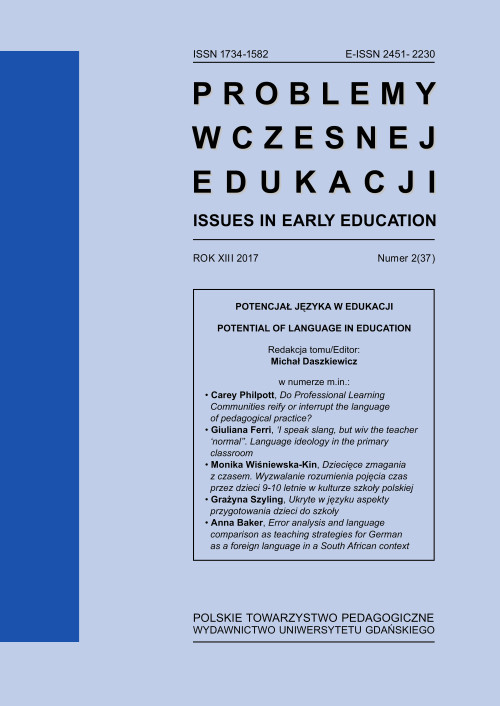Polish as L1, English as L2: the linguistic transfer impact on Second Language Acquisition stemming from the interlingual differences: implications for young learners education
DOI:
https://doi.org/10.5604/01.3001.0010.5589Słowa kluczowe:
angielski jako język obcy, polski jako L1, transfer językowy, przejrzystość języka, nabywanie języka obcegoAbstrakt
Research has shown that learners of different linguistic backgrounds make similar errors, which is due to linguistic transfer. Cross-linguistic similarities between L1 and L2 can result in: positive transfer, negative transfer, and differing lengths of acquisition. The bigger the difference between the languages, the bigger Second Language Acquisition difficulties and more numerous potential negative transfer areas. This effect is visible in the case of Polish as L1 and English as L2. English and Polish differ in terms of pronunciation (e.g. vowel-based vs. consonant-based), spelling (e.g. opaque vs. semi-transparent), grammar (e.g. fixed vs. flexible word order), syntax (e.g. analytic vs. synthetic), and vocabulary. Therefore, second language instruction should include the errors caused by linguistic transfer, which would facilitate the selection and development of effective instruction methods and techniques.68-76
Downloads
Bibliografia
Al-Qahtani M.F. (2013), Relationship between English Language, Learning Strategies, Attitudes, Motivation, and Students’ Academic Achievement. “Education in Medicine Journal”, 5(3).
Alexander R. (2010), Speaking but not listening? Accountable talk in an unaccountable context. “Literacy”, 44(3), doi:10.1111/j.1741-4369.2010.00562.xAusubel D.P. (1964), Adults versus Children in Second-Language Learning: Psychological Considerations. “Modern Language Journal”, 48 (7).
Cummins J. (1991), Interdependence of First- and Second-Language Proficiency in Bilingual Children. In: E. Bialystok (ed.). Language Processing in Bilingual Children. Cambridge, Cambridge University Press.
Doroszewski W., Wieczorkiewicz B. (1972), (eds). Fonetyka. Części Mowy. Słowotwórstwo. Warszawa, Państwowe Zakłady Wydawnictw Szkolnych.
Dz.U. (Journal of Legislation of the Republic of Poland) of 2014, item 803.
EC (2007). Commission of European Communities, Final Report, High Level group on Multilingualism. Luxembourg.
Erickson K., Sachse S. (2010), Reading Acquisition, AAC and the Transferability of English Research to Languages with More Consistent or Transparent Orthographies. “Augmentative and Alternative Communication”, 26 (3).
Eurydice (2005), Key data on teaching languages at school in Europe. Brussels, European Commission.
Forel C.A., Puskas G. (2005), Phonetics and Phonology. Reader for First Year English Linguistics. Geneva, University of Geneva Fromkin V., Rodman R. (1993), An Introduction to Language. Philadelphia, Harcourt Bruce College Publishers.
Gajewska-Dyszkiewicz A. et al. (2012), Lekcja języka angielskiego z perspektywy uczniów klas trzecich gimnazjów. “Edukacja”, 3 (119).
Gajda S. (1999), O językowym planie wyrażania, czyli o… Logopedia. Pytania I Odpowiedzi. Podręcznik Akademicki. Eds. Gałkowski, Tadeusz and Grażyna Jastrzębowska. Opole, Uniwersytet Opolski.
Komorowska H. (2009), Metodyka nauczania języków obcych. Warszawa, Fraszka Edukacyjna Lewandowska A. (2013), The Effectiveness of Data-Driven Learning Techniques in Eliminating Polish Advanced EFL Learners’ Interference Errors. Unpublished Doctoral Dissertation. Poznań, Uniwersytet im. Adama Mickiewicza w Poznaniu.
Łockiewicz M., Jaskulska M. (2016), Difficulties of Polish students with dyslexia in reading and spelling in English as L2. Learning and Individual Differences, 51, doi: 10.1016/j.lindif.2016.08.037.
Malczewski J. (1990), Nauka O Języku. Słownik szkolny. Warszawa, Wydawnictwa Szkolne i Pedagogiczne.
Melby-Lervåg M., Lervåg A. (2011), Cross-Linguistic Transfer of Oral Language, Decoding, Phonological Awareness and Reading Comprehension: A Meta-Analysis of the Correlational Evidence. “Journal of Research in Reading”, 34 (1).
Miles E. (2000), Dyslexia May Show a Different Face in Different Languages. “Dyslexia”, 6 (3).
Milewski S. (1999), Lingwistyczne i dydaktyczne aspekty analizy fonemowej. Lublin, Wydawnictwo Uniwersytetu Marii Curie-Skłodowskiej.
Nijakowska J. (2010), Dyslexia in the Foreign Language Classroom. Bristol, St. Nicholas House.
Odlin T. (1989), Language Transfer: Cross-Linguistic Influence in Language Learning. Cambridge, Cambridge University Press.
Paradowski M.B. (2006), Uczyć, aby nauczyć – rola języka ojczystego w gramatyce pedagogicznej i implikacje dla dydaktyki języków obcych. W: J. Krieger-Knieja, U. Paprocka-Piotrowska (eds.). Komunikacja językowa w społeczeństwie informacyjnym – nowe wyzwania dla dydaktyki języków obcych. Lublin, Towarzystwo Naukowe KUL.
Porayski-Pomsta J., Podracki J. (1996), Nasz Ojczysty Język. Gramatyka, Ortografia i Interpunkcja. Warszawa, Wydawnictwo Oświata.
Ryndak L. (2014), The International and Slavonic Phonetic Alphabets. “Beyond Philology”, 11.
Selinker L. (1992), Rediscovering Interlanguage. London, Longman.
Song Y. (2015), L2 Processing of Plural Inflection in English. “Language Learning”, 65 (2).
Tokarski J. (1978), Fleksja Polska. Warszawa, PWN.
Weinreich U. (1968), Languages in contact. Findings and problems. The Hague, Mouton Publishers.
Ziegler J.C., Goswami U. (2006), Becoming Literate in Different Languages: Similar Problems, Different Solutions. “Developmental Science”, 9 (5).

 Uniwersyteckie Czasopisma Naukowe
Uniwersyteckie Czasopisma Naukowe





